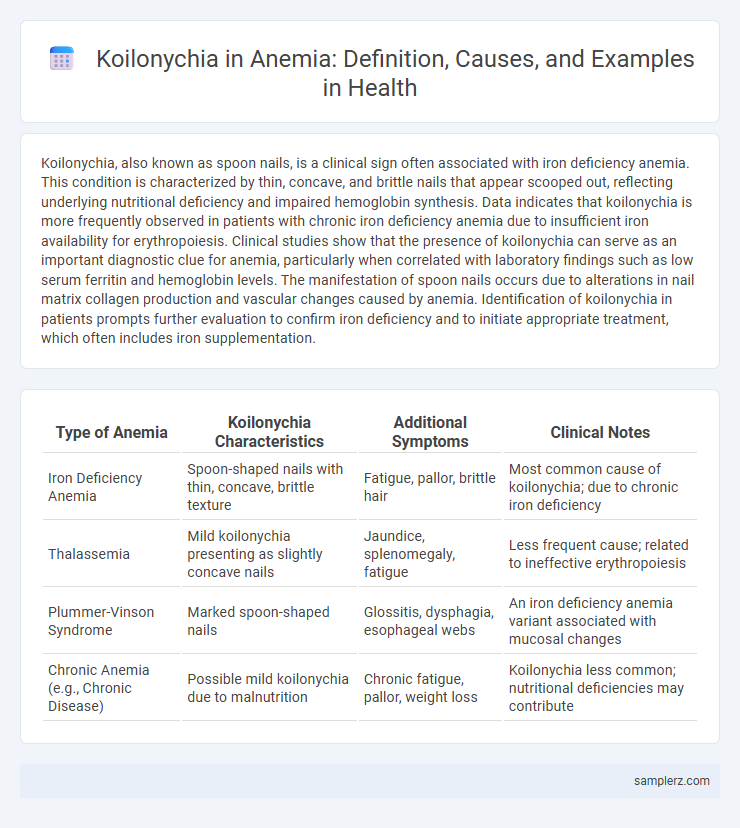Koilonychia, also known as spoon nails, is a clinical sign often associated with iron deficiency anemia. This condition is characterized by thin, concave, and brittle nails that appear scooped out, reflecting underlying nutritional deficiency and impaired hemoglobin synthesis. Data indicates that koilonychia is more frequently observed in patients with chronic iron deficiency anemia due to insufficient iron availability for erythropoiesis. Clinical studies show that the presence of koilonychia can serve as an important diagnostic clue for anemia, particularly when correlated with laboratory findings such as low serum ferritin and hemoglobin levels. The manifestation of spoon nails occurs due to alterations in nail matrix collagen production and vascular changes caused by anemia. Identification of koilonychia in patients prompts further evaluation to confirm iron deficiency and to initiate appropriate treatment, which often includes iron supplementation.
Table of Comparison
| Type of Anemia | Koilonychia Characteristics | Additional Symptoms | Clinical Notes |
|---|---|---|---|
| Iron Deficiency Anemia | Spoon-shaped nails with thin, concave, brittle texture | Fatigue, pallor, brittle hair | Most common cause of koilonychia; due to chronic iron deficiency |
| Thalassemia | Mild koilonychia presenting as slightly concave nails | Jaundice, splenomegaly, fatigue | Less frequent cause; related to ineffective erythropoiesis |
| Plummer-Vinson Syndrome | Marked spoon-shaped nails | Glossitis, dysphagia, esophageal webs | An iron deficiency anemia variant associated with mucosal changes |
| Chronic Anemia (e.g., Chronic Disease) | Possible mild koilonychia due to malnutrition | Chronic fatigue, pallor, weight loss | Koilonychia less common; nutritional deficiencies may contribute |
Understanding Koilonychia: Definition and Clinical Significance
Koilonychia, characterized by spoon-shaped nails, is a clinical indicator often associated with iron-deficiency anemia, reflecting disrupted keratin synthesis and capillary hypoxia. This nail deformity signifies chronic anemia's impact on peripheral tissues, aiding clinicians in early diagnosis and management. Recognizing Koilonychia enhances understanding of anemia's systemic manifestations and guides appropriate therapeutic interventions.
Koilonychia as a Symptom of Iron Deficiency Anemia
Koilonychia, characterized by spoon-shaped, thin, and brittle nails, is a hallmark symptom of iron deficiency anemia resulting from reduced hemoglobin synthesis and impaired oxygen delivery. This nail deformity arises due to iron's critical role in collagen maintenance and nail matrix function, often signaling prolonged iron deficiency. Identifying koilonychia aids clinicians in diagnosing iron deficiency anemia early, prompting timely interventions to restore iron levels and prevent further complications.
Recognizing the Visual Signs of Koilonychia in Patients
Koilonychia, commonly known as spoon nails, presents as thin, concave, and brittle nails often seen in patients with iron-deficiency anemia. Recognizing these distinct visual signs, including the characteristic scooped-out appearance and fragility of the nail surface, aids clinicians in early diagnosis. Careful examination of nail morphology can therefore serve as a non-invasive indicator of underlying systemic iron deficiency.
Common Causes of Koilonychia in Anemic Individuals
Koilonychia, commonly known as spoon nails, frequently occurs in individuals with iron deficiency anemia due to insufficient hemoglobin production impairing oxygen transport and nail matrix health. Other prevalent causes in anemic patients include chronic blood loss, nutritional deficiencies such as vitamin B12 or folate, and conditions like plummer-vinson syndrome that exacerbate iron depletion. Understanding these underlying causes is crucial for accurate diagnosis and effective treatment of koilonychia linked to anemia.
Case Study: Koilonychia Presentation in Severe Anemia
A 45-year-old female patient presented with severe iron-deficiency anemia accompanied by koilonychia, characterized by thin, spoon-shaped nails with concave deformities. Laboratory tests revealed hemoglobin levels at 6.5 g/dL and serum ferritin below 10 ng/mL, confirming the diagnosis of iron-deficiency anemia as the underlying cause of nail changes. Treatment with oral iron supplementation led to gradual improvement of both anemia and nail morphology over three months.
Diagnostic Approach to Koilonychia in Anemia Evaluation
Koilonychia, characterized by spoon-shaped nails, commonly indicates iron-deficiency anemia and warrants a thorough diagnostic approach including complete blood count (CBC), serum ferritin, and iron studies to assess anemia severity and iron status. Nail biopsy is rarely necessary but may differentiate koilonychia from other nail disorders if clinical suspicion persists. Early identification through these diagnostic tools facilitates targeted iron supplementation and underlying cause evaluation, improving patient outcomes.
Associated Symptoms: Koilonychia and Other Anemia Indicators
Koilonychia, characterized by spoon-shaped nails, often indicates iron-deficiency anemia and is commonly accompanied by pallor, fatigue, and shortness of breath. Other associated anemia symptoms include brittle nails, glossitis, and tachycardia, reflecting the reduced oxygen-carrying capacity of the blood. Recognizing Koilonychia alongside these clinical signs aids early diagnosis and management of underlying anemia.
Management and Treatment Options for Koilonychia in Anemia
Management of koilonychia in anemia focuses on treating the underlying iron deficiency through oral or intravenous iron supplementation, which helps restore normal nail morphology. Dietary modifications to include iron-rich foods such as red meat, leafy greens, and legumes support recovery alongside medical therapy. Monitoring hemoglobin levels and iron stores guides the duration and effectiveness of treatment, reducing nail deformities associated with anemia.
Preventive Strategies for Koilonychia in At-Risk Populations
Preventive strategies for koilonychia in at-risk populations with anemia include maintaining adequate iron levels through dietary intake of iron-rich foods such as lean meats, legumes, and leafy green vegetables. Regular screening for iron-deficiency anemia, especially in women, children, and individuals with chronic illnesses, facilitates early intervention to prevent nail deformities. Supplementation with iron and addressing underlying causes of anemia reduces the incidence of koilonychia and promotes overall nail health.
Prognosis and Recovery: Outcomes for Anemia-Related Koilonychia
Koilonychia, often seen in iron-deficiency anemia, typically shows improvement with appropriate iron supplementation and correction of underlying causes. Prognosis is favorable when anemia is treated promptly, leading to normalization of nail structure and function within weeks to months. Persistent koilonychia may indicate chronic or untreated anemia, requiring further medical evaluation to prevent complications.

example of Koilonychia in anemia Infographic
 samplerz.com
samplerz.com